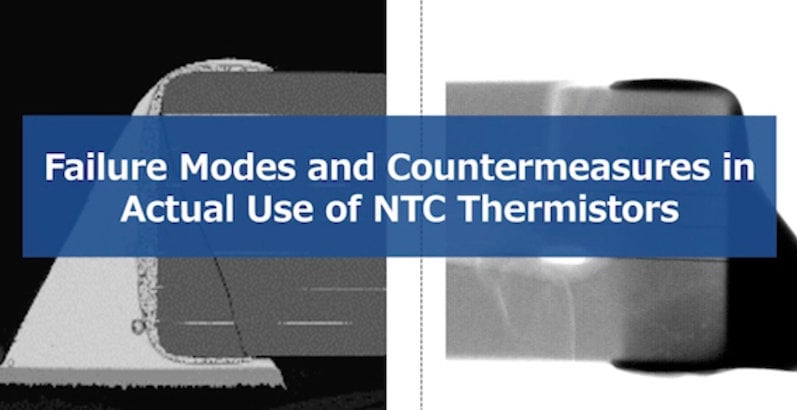electronics-journal.com
23
'23
Written on Modified on
TDK: FAILURE MODES AND COUNTERMEASURES IN ACTUAL USE OF NTC THERMISTORS
Improper use of NTC thermistors may cause malfunctions. This article introduces the causes and countermeasures for failure modes caused by the improper use of NTC thermistors.

NTC (Negative Temperature Coefficient) thermistors are thermally sensitive semiconductor resistors which show a decrease in resistance as temperature increases, and their rate of change is extremely large. The main applications include temperature sensing in electronic equipment and temperature compensation for module products.
However, if the user misuses the product, it may not function properly and, in the worst case, this may cause malfunctions.
Failure Mode (1) <Cracks>
The most common failure mode is 'cracking'. Cracks are sometimes caused by mechanical stress during or after mounting on the board. Two common causes are "excessive solder" and "post-mounting stress".

1st Cause: Excessive solder
When mounting NTC thermistors on boards, excessive solder may cause cracking. As the solder quantity increases, the stress on the NTC thermistor increases. This is due to bending stress caused by the solder, which may lead to cracking when the applied solder is too much. However, if there is too little solder, there is a risk of poor connection or chip or the joint may be unstable. Therefore, it is important to apply an appropriate quantity of solder.
Countermeasures
When designing the land pattern on the board, set the pattern shape and dimensions to ensure the appropriate application of the solder. By designing the land pattern according to the recommended dimensions, you can avoid excessive or insufficient solder quantity.
2nd Cause: Post-mounting stress
If an NTC thermistor is solder-mounted on a mounting board that has been deformed due to a split plate or screw, cracks may occur due to stress. In particular, it is important to note that the NTC thermistor is more prone to high amount of stress around the split plate.
Countermeasures
This stress due to the bending of the board varies greatly depending on the placement of components on the board where the NTC thermistor is mounted. As an example, stress can be reduced by placing the chip parallel to the split-plate surface rather than perpendicular to it. Also, the further away it is from the split plate section, the more stress is reduced.
The risk of cracking can be greatly reduced by designing the board so that the NTC thermistor is positioned against bending stress. In addition, even without split plates, cracking may still occur due to deflection stress caused by bending of the board, dropping, or impact. After mounting the NTC thermistor, please be careful not to apply external stress to the board.
Failure mode (2) <Melting of ceramics>
Since NTC thermistors are temperature-sensing devices, self-heating should be reduced as much as possible in order to accurately detect temperature. However, there are cases where the thermistor’s temperature exceeds its melting point, which could melt the board if excessive electrical load continues to be applied.

Cause: Overcurrent
As mentioned earlier, one of the causes of ceramics melting is the application of a large electrical load to the NTC thermistor.
Since NTC thermistors have a negative electrical resistance in relation to temperature, their resistance decreases due to self-heating that occurs when excessive current flows through them.
Due to these electrical characteristics, continuous overcurrents that greatly exceed the allowable operating current can lead to "overheating," in which a decrease in resistance due to self-heating alternates with an increase in current due to the decrease in resistance. Then, if the internal temperature of the element exceeds the melting point of the ceramics, the element will melt.
Countermeasures
Make sure the components and design circuits do not apply current exceeding the permissive operating current. For example, for our 1.0 x 0.5 mm NTC thermistors, the permissive operating current is specified as 0.03 to 0.21 mA. The permissive operating current is specified for each part number and should be in accordance with the specified value of each NTC thermistor manufacturer.
As a countermeasure against overcurrent, a voltage divider circuit using a fixed resistor is effective.
www.tdk.com

